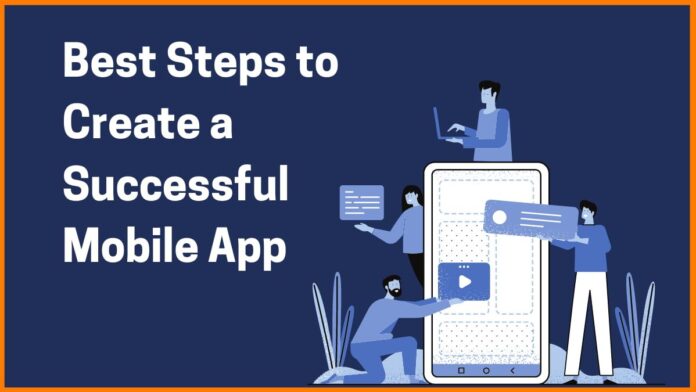It isn’t easy to create a mobile app that works. We’ve covered many aspects of creating a mobile app on our blog. We discussed what a mobile application is, how it works, and what the cost of developing one in 2022.
What does it take for a mobile app to be successful? We asked three experts in the areas of UX/UI design, business development, technology, to help us tackle this issue.
Learn how to build a mobile app that achieves your business goals and brings you fame and glory.
Skip to the next section
- Business
- UX app design
- UI app design
- Technology
- Summary
- Business perspective on how to create a mobile app that is successful
Here are some tips from our Business Analyst:
Identify the key factors that make success possible.
Before you can determine whether or not your application is successful, you must first define success for yourself. It all comes down to the events or metrics that occur during the application’s life cycle. These are your objectives.
What else can you talk about success? A successful mobile app is one that has many users and receives a lot of traffic. You can also add parameters to suit your business such as financial or quality.
These metrics and KPIs can help you gauge the impact of your digital products on your target audience
- Active users daily and monthly
- Daily sessions for daily active users
- Rate of retention
- Churn rate
- Cost per acquisition (CPA)
- User lifetime value (LTV)
- Find out the problem that your app was designed to solve
Remember that a mobile app is just a tool. Your product’s ultimate success will be determined by its ability to help users solve their problems. The simple task of identifying the problem is often difficult for business owners.
Even the most appealing application, based on innovative technologies and without bugs, won’t guarantee success if its primary role is to solve a business problem.
How do you explore the problem that your app solves
Begin by identifying your target audience. Learn more about them, not just their demographic data but also their preferences regarding digital products.
Product Canvas allows you to consolidate all your marketing materials and validate your solutions. Product Canvas allows you to combine user stories with storyboards, personas and design sketches.
Your app should be prepared from a marketing perspective
You must create a brand image for your app that communicates the purpose of your app to your target audience. You should clearly communicate to your target audience the needs that your app meets or the problems it solves. Your application should be easy to find among the multitude of mobile apps.
Flexibility is important, but you must know your limits
Software development guides will tell you that we must all be agile to respond to changing customer needs. This approach is usually successful. But, pivoting can have serious consequences.
Early detection is key
The most common problem for business owners, and especially founders of startups, is being too optimistic about the product. Too optimistic about your product is a problem for business owners and startup founders. It’s fine to be passionate about your vision. It’s safer to be realistic about the risks and difficulties in business.
Let’s summarize the business tips for creating a mobile app that is successful before we move on.
- UX design
Here are some tips from Jakub, our UX/UI Designer:
Define your target audience
Without this step, it is impossible to achieve success. Before you start building your product, it is important to understand who and what your application will be used for. This section explains the basics of this step. In the context of UX, the problem is more about identifying how each element of your app creates an efficient user flow that directs users to their goal.
Make sure you are usable
Make sure your solution is clear and easy to use. This means that users can perform tasks efficiently while still enjoying the experience. Do not reinvent the wheel. Common themes, transitions and icons can be used. These features can be found in UI toolkits and starter kits such as this one. This is how you ensure that your app is simple to use by people who are familiar with using mobile apps.
You can find the Top 24 E-Commerce Mobile App Features here if you are building an mcommerce app.
Trust builds
Your application must make users feel valued and unique in order to be successful. Trust and transparency are the key principles that should guide interactions between users and the application.
Take the time to listen to your users
Remember that your target audience is not the intended user of the application you are building. You need to monitor how users respond to your application. Ask your users to rate your app, take in-app Net Promoter Score (NPS) surveys and use beta testing.
Use user feedback to improve your application. Your user base will always give you feedback and help you improve your application. This is the best way to succeed.
- UI design
Attract the attention of customers
Expect to be faced with a lot competition when you release a mobile app. Your app should be attractive to users. This can be achieved by investing in custom designs, animations, illustrations, and even 3D images.
Make the interface accessible
Your app’s user interface should be easy to use, simple, and clear. To avoid distracting users from elements that create the user flow, focus on the most important features of your app. Visual hierarchy is the balance between visual elements. The most important elements of your app should be visible more than the less important. This article will provide more information about the latest trends in mobile app design.
Accessibility is important!
Your application should be accessible. Pay attention to the needs of those with disabilities. Remember to use the right contrast when designing user interfaces.
- Technology
Here are some tips from Damian, our iOS and Flutter Developer:
Select the technology stack
Your choice of technology to build your digital product is crucial. There are many options available depending on your timeframe, budget and the complexity of your app.
There are three options available when building a mobile application development: cross-platform, native, or hybrid.
- Native mobile development
This means you will have to build your solution for each operating system individually. This requires that teams follow platform-specific guidelines and use different software environments and interface elements for each operating system. It is easy to integrate native solutions into the mobile ecosystem, providing users with outstanding stability, speed, security, and speed. Many businesses prefer native solutions to cross-platform or hybrid app development.
This approach is expensive because it requires two teams to complete your application project. Each team can only work on one platform.
- Cross-platform mobile development
These apps can be used on multiple OS. All it takes to write a single code base which can later be used for different operating system simultaneously.
Cross-platform solutions are popular because they allow business owners to get their apps to market faster and with a lower budget. A cross-platform solution will also reach a wider audience.
A cross-platform solution may not offer the same performance and user experience as native solutions, depending on which technology you choose. Flutter and React Native are two of the most widely used cross-platform technologies today.
You can read more about Flutter vs.React Native in this article: What to choose in 2021?
- Hybrid mobile development
Hybrid apps are websites that have been packaged in native containers. This is how hybrid applications can access certain platforms and device features. These apps are created using standard web tools and technologies like HTML 5, CSS and JavaScript. Hybrid apps can be distributed via app stores and look native.
A hybrid solution can be a great solution because it works on multiple platforms. Hybrid solutions are generally faster to launch and require less development.
They can also lead to slower performance, code vulnerabilities that are more likely, scalability issues, and costly maintenance after release.
Select the supported platforms, devices and systems
Before you launch the development phase, it is important to determine which operating systems, devices, and technologies your app will support. Pay attention to the market share for each technology when you make a decision about which operating system versions.
Your application will need more development work the more systems you choose to support. Budget is also a key factor in this decision. To balance accessibility and costs, you should take a look at the market.
Select your app monetization strategy
Your application must generate revenue in order to be successful. You should start looking at your monetization options as early as possible in the planning phase. For example, you can:
You can offer your app for a fee in the app store. In this version, users will need to pay a certain amount before they can download the app onto their devices.
Rely on in app ads and purchases. This strategy is designed to provide app users additional features or useful elements for a fee.
Subscriptions can be launched – they are sub-types of in-app purchase. The way they work is that users download an app and often get a free trial so they can try all the features. When the trial period is over, they need to pay a weekly/monthly/yearly fee to maintain access to these features.
Each strategy has its pros and cons so make sure you do your research before you settle on one.
Create an MVP
The first thing you should do is create a Minimum Viable product (see what MVP stands for). You can gather feedback and analyze the reactions of your target audience by delivering a basic product to them. Then, you can make any necessary changes or improvements. You will be able to build a digital product that your target audience loves.
Rely on solid app development processes
Before you start to work on your application, plan how it will be built. This is when the development team selects the tools, libraries and software architecture. These decisions are often made right after the app requirements have been defined. Get our free guide for product owners: Take your product to success.
Summary: How to make a mobile app that is successful
We hope you find our best tips and practices useful in creating a mobile app that is successful. The success of your mobile app in the market depends on several factors. These include its usability, ability to solve problems efficiently, and how it addresses key needs of your users. These tips will help you position your app to be a success from the beginning.
Why not outsource app development for Droids On Roids instead?
Artoon Solutions has been providing iOS and Android app development services since more than nine years. We have helped companies from all over the globe, including the USA, UK and Norway. More than 500 web and mobile applications were developed for clients in many different industries.
To provide the highest quality development services to our clients, our teams use a six-step Quality Assurance Process. To deliver the best business value, we also use the Scrum framework as well as other industry standards.
Get in touch with us if you are looking for a mobile app development team. We have the expertise and talent to make your app a success.
















